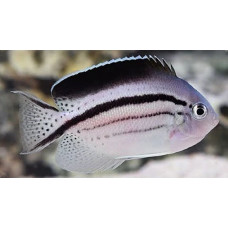Latin name
Genicanthus lamarck
Other name
Lamarck's angelfish
Identification
This species was first officially described in 1860 by the French naturalist Bernard Germain de Lacépède (1756-1825) as Holocanthus caudovittatus, without specifying the locality. The species name was given in honor of the French naturalist Bernard Germain de Lacépède (1744-1829). The species is known to have been hybridized with the Beautiful Angelfish (Genicanthus bellus).
Features of fish fins
The dorsal fin has 15 spines and 15-16 soft rays, while the anal fin has 3 spines and 16-17 soft rays.
Fish colouring
Adult Genicanthus lamarck have a pale grayish to whitish coloration marked by 4-5 black wavy irregularly shaped stripes that diverge from the eye and run horizontally along the sides. The dorsal fin has a broad black underwater stripe and the caudal fin is covered with small spots. Females and juveniles have a broader upper stripe. Males have a yellow spot on the dorsal fin, black pelvic fins, and very elongated blades on the caudal fin. In addition, males have black pelvic fins and white caudal fin lobes, while females have white pelvic fins and black caudal fin lobes.
Distribution
Genicanthus lamarck is found from the Gulf of Thailand east through the Malay Archipelago to the Solomon Islands, north to southern Japan and south to the Great Barrier Reef. Its Australian distribution includes Ashmore Reef and Cartier Island in the Timor Sea.
Habitat
Genicanthus lamarck is found at depths of 10 to 50 meters (33 to 164 feet). It lives in areas of dense coral growth on seaward reef slopes and steep cliffs.
Size
This species reaches a maximum total length of 25 centimeters (9.8 inches).
Behavior
These fish do not migrate. They form feeding aggregations in the middle part of the water, well above the bottom.
Food and feeding habits
Their usual food is zooplankton.
Reproduction
This species usually lives on the bottom in small harems with one dominant male and 2-6 females. They are sequential protogynous hermaphrodites, and if a male in the harem is lost, the dominant female will change sex to male.
Fishing
Have little commercial value to local fishermen.
Relationship with a person
The Blackstriped Angelfish is often found in aquarium shops. It is also considered a delicacy in the Moluccas.
| Classification | |
| Phylum | Chordata |
| Class | Actinopterygii |
| Squad | Perciformes |
| Family | Pomacanthidae |
| Genus | Genicanthus |
| Species | G. lamarck |
| Features | |
| Conservation status | Least Concern |
| Habitat | Pelagic |
| Life span, years | No information |
| Maximum body weight, kg | No information |
| Maximum length, cm | 25 |
| Sailing speed, m/s | No information |
| Threat to people | Edible |
| Way of eating | Planktonophage |
Blackstriped angelfish
Tags: blackstriped angelfish



